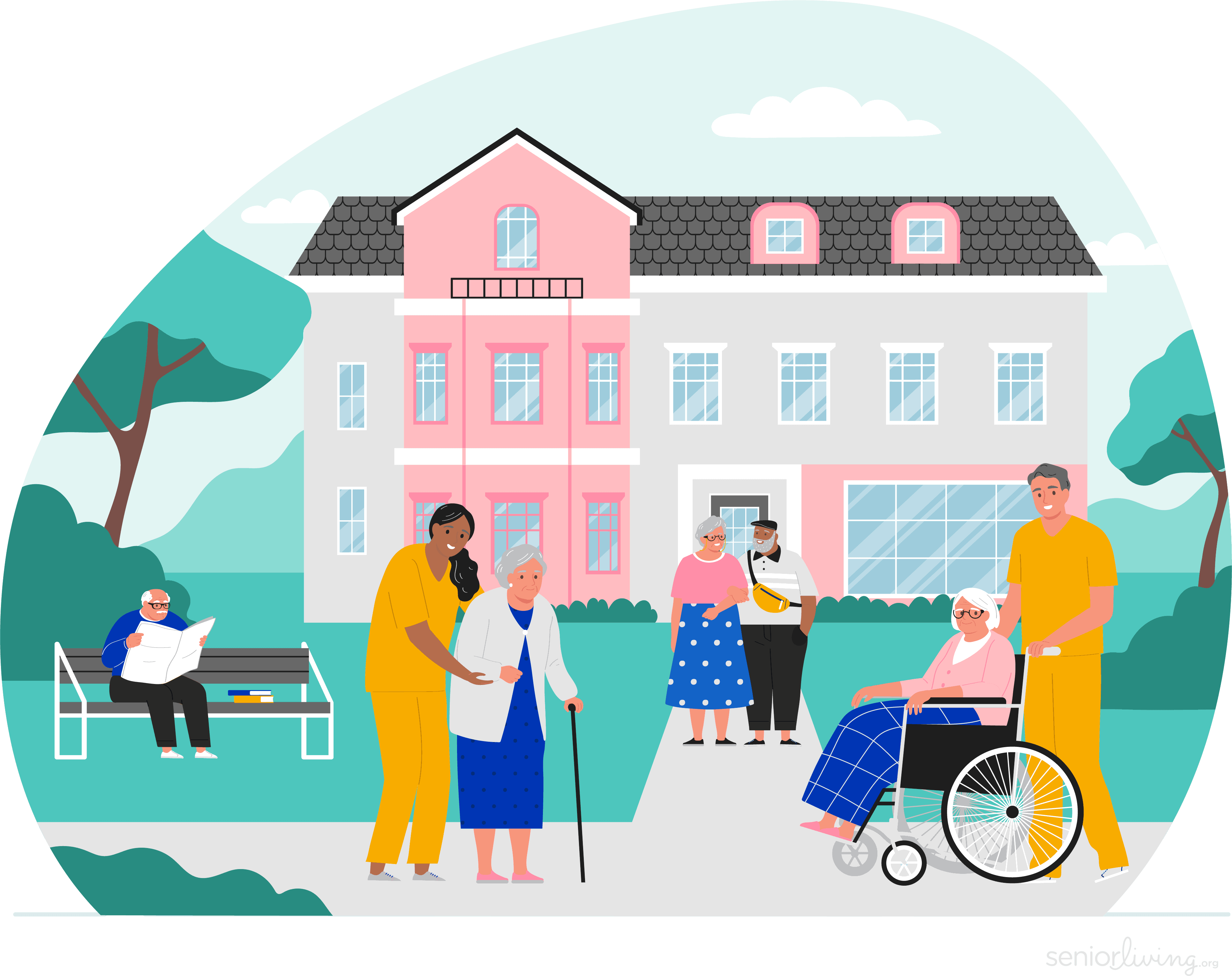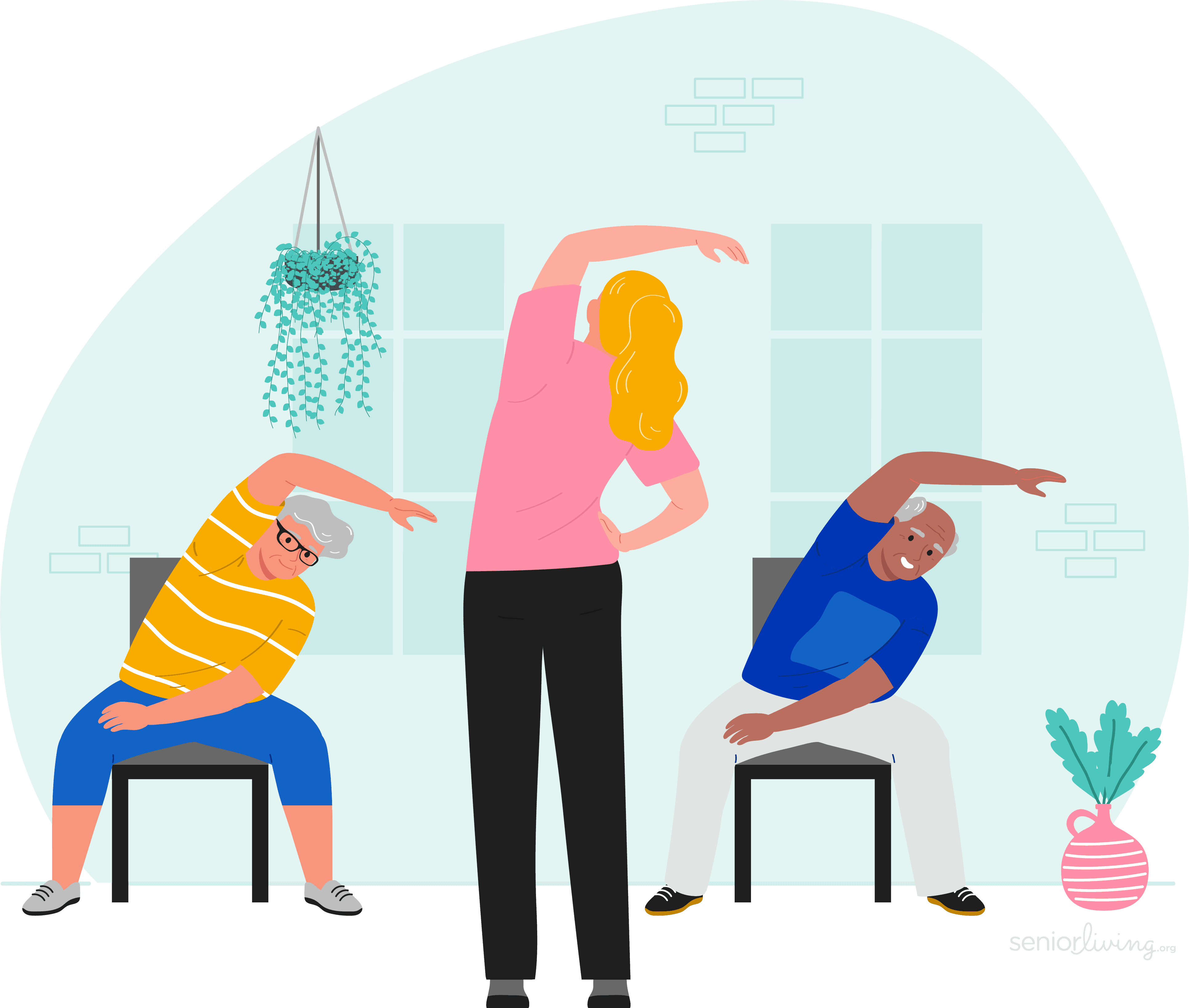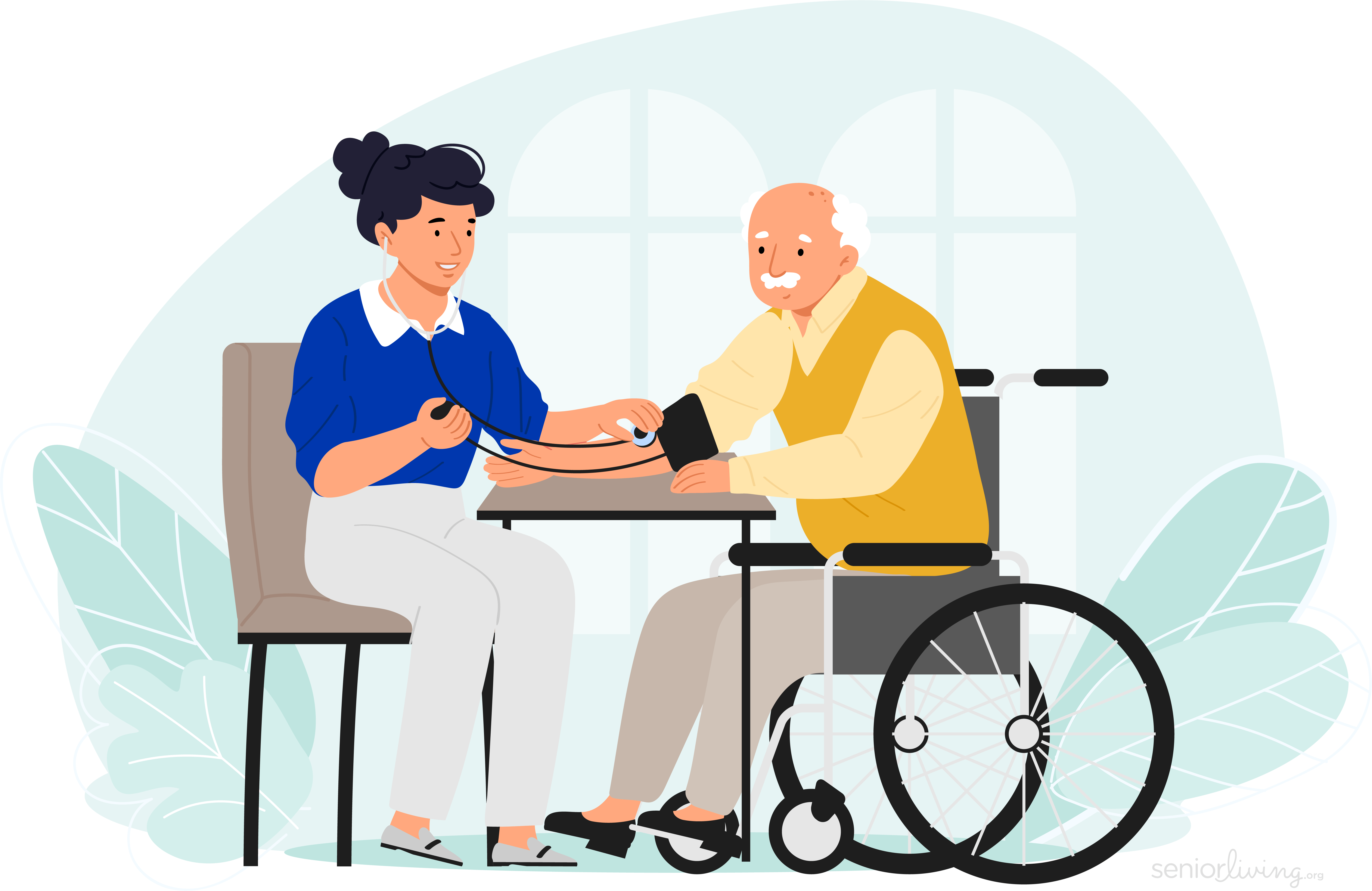Assisted living is a residential option that can provide safety, comfort, and promote socialization for seniors who need a little help with the activities of daily life. Assisted living is not the same thing as a nursing home. It also differs from independent living communities. Assisted living communities can include private apartments or cottages, and some also offer the option of shared living quarters. Assisted living communities can be a good choice for seniors who are in a couple as well as those who are single.
If living alone has become more challenging, or you're looking for a community and opportunities to socialize, an assisted living facility may be a great choice. Most assisted living facilities offer services such as meals, housekeeping, and medication management. Some also offer amenities like fitness centers, transportation services, and outdoor spaces to encourage health and well-being. Some even allow pets! And importantly, because loneliness can contribute to mental and physical decline1, connections and friendships fostered in an assisted living community can be great for your health.
Before you visit assisted living communities near you, you may wonder what it’s like to live there. You might have questions such as, “What do the fees include? Are there rules that may not mesh well with some lifestyles?” Keep reading for the inside scoop! In the years I worked at an assisted living facility, I spoke with dozens of residents who call assisted living facilities home. Their insights and my experience informed our guide, so let’s jump in and see if assisted living is right for you!f
Before you visit assisted living communities near you, you may wonder what it’s like to live there. What is included in the fee? Are there rules that may not mesh well with some lifestyles? I can give you the inside scoop! During the years I worked for an assisted living facility, I spoke with dozens of residents who call assisted living home. Let’s jump in to see if assisted living is right for you!
Our Assisted Living Guide Includes:
Our free housing and care finder uses your unique needs to curate a list of the best options in your area.
What Is Assisted Living?
Assisted living is designed to provide long-term housing for older adults who require assistance with daily living tasks (ADLs) such as laundry, cooking, cleaning, and medication management. This support helps older adults maintain good health. It's ideal for active and social older adults or couples who require assistance with day-to-day tasks. Seniors and their adult children can take comfort in knowing that 24/7 support is available. If you or a loved one isn’t ready to transition into an assisted living facility, check out our guide to independent senior living.
For more details on assisted living, check out the video below with our Editor-in-Chief, Jeff Hoyt.
What Care Is Provided in Assisted Living?
Services provided in an assisted living community will vary, but generally, you can expect meals, laundry, housekeeping, and maintenance to be taken care of.
According to the National Center for Assisted Living,2 typical services provided by assisted living communities include:
- Round-the-clock supervision and assistance.
- Exercise, health, and wellness programs.
- Laundry, cleaning, and other housekeeping and maintenance services.
- Personal care and help with activities of daily living.
- Meals and dining services.
- Medication management.
- Transportation services.
Some assisted living communities offer services “a la carte,” meaning they cost extra. Typically, services that communities might charge additional monthly fees for include salon services, garage or carport space, and physical and occupational therapy. When touring the community, ask whether these sorts of perks are included in the monthly base rate.
Are There Different Levels of Assisted Living?
There are typically three levels of care in assisted living communities. Levels of care are based on the assistance a resident needs with the six main activities of daily living (ADLs).3
Basic ADLs include:
- Dressing
- Using the restroom
- Personal hygiene and grooming
- Ambulating
- Continence
- Feeding
These different levels of care allow residents to remain in their assisted living homes long-term. For example, if a senior's health status changes and they need additional support, they can move to the next level of care within assisted living. That saves the hassle of moving to a new room or different facility entirely.
Generally, the higher the care level, the more assistance you will require from staff, which increases your care costs. You must be honest and open during assessments (most communities schedule regular evaluations of residents' care needs) to ensure you get the care you need to stay safe and healthy. Though it will vary slightly from place to place, below is a general structure for reference:
| Care level | May include | Best for |
|---|---|---|
| Level one: Lowest care |
|
Seniors who are mostly independent but need some reminders throughout the day |
| Level two: Moderate care |
|
Seniors with some mobility impairment requiring assistance, but are still able to eat on their own |
| Level three: Highest care |
|
Seniors who have severe physical or cognitive impairment and need assistance with the majority of daily tasks |
Do I Qualify for Assisted Living?
If cooking, cleaning, and managing your medication is overwhelming and tiring, assisted living may be for you. If you’re generally still active and can get around well on your own or with the assistance of a cane or walker, you may benefit from assisted living, where many daily tasks are taken care of for you. It frees up your time and energy to enjoy hobbies, spend time with friends and family, and volunteer if you'd like.
Some signs that you or your loved one may be ready for assisted living include:
- Loneliness and depression
- Trouble managing money and paying bills
- Worsening health condition
- Inability or difficulty cooking and cleaning
- Help needed with personal care and managing medication
- Increased risk of falling or have had multiple falls
SeniorLiving.org Is Now Livestreaming
We are hosting live Q&As with senior care and housing experts on our YouTube channel. Check out one of our latest streams below and tune in to upcoming streams @SeniorLiving.Org on YouTube!
How Much Does Assisted Living Cost?
According to the Genworth Cost of Long-Term Care Survey, the estimated median cost of assisted living in 2025 is $6,077 per month.4 Prices vary from about $3,000 to $7,000 per month, depending on location and other factors. However, costs can exceed that upper limit in some regions. For example, assisted living in Hawaii can surpass $10,000 per month.
Costs depend on the usual housing factors (e.g., room size, amenities, and geographic location), plus care services. Residents may have separate fees for assistance with laundry, pet care, physical therapy, and other needs. If the need for care advances, a person might bring in extra help to avoid transferring to a nursing home.
FYI: Assisted living costs vary greatly depending on the location. For example, average prices for assisted living in Mesa, Arizona, will vary wildly from Denver assisted living communities.
So, how do you pay for assisted living? Many combine their resources, such as personal savings, Medicaid, long-term care insurance, and veterans’ benefits. It’s important to note that Medicare doesn't cover assisted living costs, and some facilities don’t accept Medicaid. Some communities have staff available to guide you through the options and paperwork; however, you can hire a geriatric planner (or lawyer) to walk you through.
How to Research Assisted Living Facilities
Figuring out whether assisted living is right for you or a loved one may feel like quite an undertaking, which is why enlisting trusted support and expert guidance can relieve some of the burden.
Consider taking these first steps to help find an assisted living community in your area:
- Search our assisted living directory.
- Ask your health care provider which assisted living communities they recommend.
- If you have friends or family living in a local assisted living community, ask them about their experience and recommendations.
How to Find the Right Assisted Living Community
You can find the right assisted living community by visiting several facilities in person. To find communities near you, search the SeniorLiving.org housing directory. When touring an assisted living facility, evaluate cleanliness and the personal interaction between residents and each other, as well as with staff. Remember, for a high quality of life, it’s critical to find a good social match, not just a facility that meets basic needs.
Visiting assisted living communities will give you a better idea of the social setting, activities, and culture the community fosters. Eating a meal at the facility can be a great way to gain an insider's view. Arrange an interview over lunch or dinner at the facility, if possible. It will also give you insight into the expected menu and food quality, if that's particularly important. A good alternative is to observe a class or club meeting, if available. This will provide insights into the social climate in the community and the sorts of activities offered to residents.
Questions About the Home or Facility
- How many people live at the facility? What is the ratio of caregivers to residents?
- Does the facility feel home-like? Do you like the décor?
- What are the apartment and room choices? Do you have an entire apartment with a kitchen?
- Do you have a private bath? Will you share an apartment?
- Does the residence have a dog or a cat? Can residents bring their pets? What are the restrictions regarding pets? For example, are fish allowed but not mammals, or do dogs need to be under a certain weight?
- Can residents bring their furniture and decor? Are any furnishings provided?
- Is there a separate thermostat in your room?
- Is there plenty of natural lighting?
- What is the view like?
- Is there enough closet and storage space?
- Are kitchen cabinets easy to reach?
- Are the outside areas well-maintained?
- Are there any stains or odors?
- Are there social activities available?
- Are there enough common areas, such as dens and living rooms?
- Are there any security protocols or cameras to help residents feel at ease?
- Does the facility allow smoking? Can residents smoke in their rooms, or are there designated outside spaces for smoking? If medical marijuana is legal, can residents smoke it on the premises?
Questions About the People
- Are the residents clean, happy, and friendly? Don’t hesitate to ask current residents about their experiences.
- Are staff members attentive and kind?
- Would you enjoy sharing meals with the residents? Do you share common interests?
- Are the residents somewhat independent? Are there social activities in the common areas or a place where individuals can practice their faith?
- Do the residents seem happy?
Questions Related to the Safety
- Is staff available around the clock? Are all entrances and exits secured?
- Are there appropriate safety measures, such as emergency exits and smoke detectors?
- Are registered nurses on staff? If so, what are their hours, and what is the staff-to-patient ratio? If an RN isn’t on duty 24/7, it’s vital to know the center’s protocol in case of nighttime emergencies.
- Are the halls and grounds well-lit? Are there handrails in the hallways?
- Are the hallways and doorways wide enough for walkers and wheelchairs? Are there walk-in showers?
- Do the rooms and bathrooms have handrails and emergency call buttons?
- Do guests have to undergo any kind of search before entering the premises (i.e., using a metal detector)?
Questions Related to the Amenities
- Is there a monthly events calendar posted? Are the spiritual services on-site?
- Does the facility have a space for outdoor recreation? If so, ensure the area looks inviting and relatively safe from trespassers.
- Are there transportation schedules for errands and medical appointments?
- What social activities, classes, and field trips are staff-facilitated?
- Is there a craft room? Are there computers and printers? Is there a swimming pool? What about a convenience shop?
- Is the facility located near town centers or community landmarks? Be sure to inquire about the closest grocery store, church, hairdresser, movie theater, and/or library to ensure you can still enjoy in your favorite pastimes.
Other Considerations and Questions
- Is there a meal menu, and can residents choose when to eat? Do the menu selections vary from day to day?
- Determine your specific state’s licensing agency and contact them. Additionally, most states have an ombudsman program that has detailed records. These show any patterns of neglect or medication errors.
- Ask for a copy of the resident agreement spelling out the facility's obligations. It will also list the charge for extra items, like laundry service.
- How close are you to friends and relatives? Are they allowed to stay overnight?
- What is the staff-to-resident ratio? Inquire about this ratio to ensure you or a loved one is cared for. As you tour facilities, be on the lookout for staff members and check if residents appear to be attended to regularly.
- Who dispenses medication, and how much training have they had? States have different training and licensing requirements.
- What are the rules regarding moving out? Under which circumstances might a senior be asked to leave?
Find Assisted Living Near You
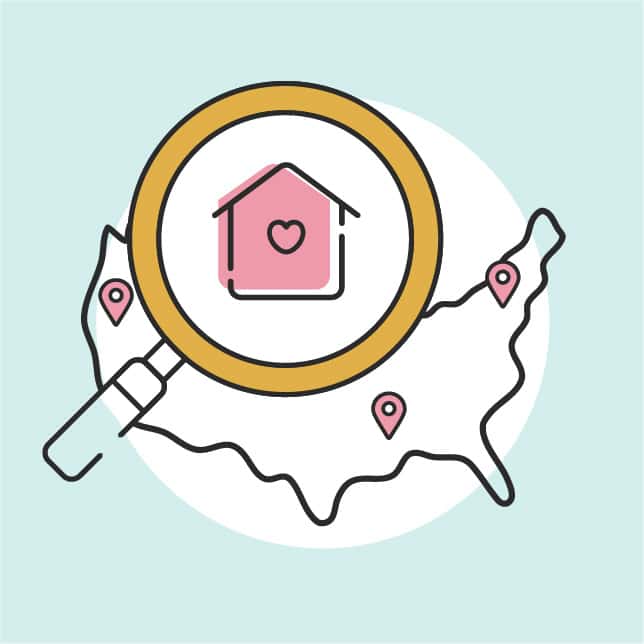
- Alabama Senior Living Communities November 17, 2025
- Alaska Senior Living Communities November 17, 2025
- Arizona Senior Living Communities October 9, 2025
- Arkansas Senior Care Communities October 10, 2025
- California Senior Living Communities May 28, 2025
- Colorado Senior Living Communities August 1, 2025
- Connecticut Senior Living October 14, 2025
- Delaware Senior Living Resources November 18, 2025
- Washington DC Senior Living Resources September 16, 2025
- Florida Senior Living Communities August 1, 2025
- Georgia Assisted Living Facilities October 10, 2025
- Hawaii Senior Living Communities October 9, 2025
- Idaho Senior Living And Senior Care October 10, 2025
- Illinois Senior Living Statistics and Facts November 18, 2025
- Indiana Senior Living Resource Guide November 18, 2025
- Iowa Senior Living And Senior Care Directory November 18, 2025
- Kansas Senior Living Communities November 18, 2025
- Kentucky Senior Care Directory October 10, 2025
- Louisiana Senior Living And Senior Care Information November 18, 2025
- Maine Senior Living Communities October 10, 2025
- Maryland Senior Living Communities August 1, 2025
- Massachusetts Senior Living Communities October 9, 2025
- Senior Living Communities In Michigan October 10, 2025
- Minnesota Senior Living Communities October 9, 2025
- Senior Care In Mississippi October 10, 2025
- Missouri Senior Living Communities October 9, 2025
- Montana Senior Care Communities November 18, 2025
- Nebraska Senior Care Directory October 14, 2025
- Nevada Senior Living Communities November 18, 2025
- New Hampshire Senior Living Communities October 10, 2025
- New Jersey Senior Living Communities October 9, 2025
- New Mexico Senior Living And Care Communities October 9, 2025
- New York Senior Living Communities October 14, 2025
- North Carolina Senior Living Communities October 9, 2025
- North Dakota Senior Care Options And Communities October 9, 2025
- Ohio Senior Living Communities October 9, 2025
- Oklahoma Senior Care Options October 10, 2025
- Oregon Senior Living Statistics and Facts October 10, 2025
- Pennsylvania Senior Care Resources November 18, 2025
- Rhode Island Senior Living Communities November 18, 2025
- South Carolina Senior Living Statistics and Facts October 9, 2025
- South Dakota Senior Care From Senior Living October 10, 2025
- Tennessee Senior Living Communities October 10, 2025
- Texas Senior Living Communities November 18, 2025
- Utah Senior Living Communities Guide October 10, 2025
- Vermont Senior Living and Senior Care October 10, 2025
- Virginia Senior Living Communities October 10, 2025
- Washington State Senior Living Communities November 17, 2025
- West Virginia Senior Living Directory October 10, 2025
- Wisconsin Senior Living Statistics and Facts August 1, 2025
- Wyoming Senior Living Statistics and Facts July 29, 2025
Find Assisted Living Options for Your Needs

- Assisted Living for Older Adults Who Are Blind December 11, 2025
- Assisted Living Options for Seniors Who Are Deaf January 2, 2026
- Assisted Living Options for Seniors With Parkinson’s Disease July 11, 2025
- Assisted Living for Seniors With Disabilities December 11, 2025
- Assisted Living for Seniors Who Have Experienced a Stroke November 18, 2025
- Non-Profit Assisted Living Facilities August 1, 2025
- Assisted Living Options for Couples November 13, 2025
- Assisted Living for Seniors With Pets November 18, 2025
- Private Duty Nursing Care For Seniors December 5, 2025
- Private Assisted Living Homes November 18, 2025
There are thousands of assisted living communities across the country, so you’re sure to find one that meets your needs. Whether you’re looking for a community that can provide specialized care for your health needs or just want a lively, social community for you and your spouse, there is an option!
Additional Assisted Living Resources
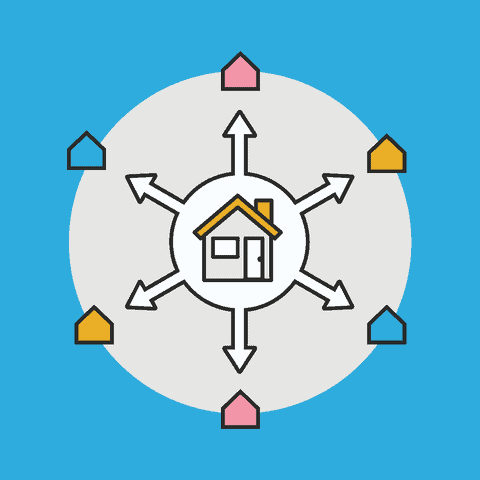
- Assisted Living Costs December 18, 2025
- Medicaid and Medicare Assisted Living Coverage December 11, 2025
- Choosing an Assisted Living Facility November 17, 2025
- Alternatives to Assisted Living November 7, 2025
- Understanding the Difference Between Assisted Living and Hospice Care November 20, 2025
- Assisted Living vs. Home Care November 20, 2025
- Compare Senior Living and Long-Term Care Options November 20, 2025
- Assisted Living vs. Skilled Nursing August 1, 2025
- Assisted Living Age Requirements November 17, 2025
Want to learn more about assisted living? From assisted living costs and Medicare coverage to tips on choosing the right community, we’ve got you covered.
FYI: Have questions about senior care or housing? We’re hosting livestreams on our YouTube @SeniorLiving.Org with experts who are ready to answer your questions and provide advice based on years of experience. Send your questions to help@seniorliving.org and we’ll answer them during our next livestream!
Assisted Living Frequently Asked Questions
- What is the average length of stay in assisted living?
Assisted living communities are designed for long-term residency. According to the American Health Care Association,5 the average stay in assisted living is 22 months. Some communities offer a trial period of 30 to 90 days for short-term stays or for potential residents to determine whether the community is a good fit for them. Although most assisted living arrangements are long-term, some older adults may move to a nursing home or facility with a higher level of care as their needs and health change over time.
- Can you leave assisted living?
Policies and procedures vary among assisted living communities for residents leaving the building. Assisted living communities typically allow residents to come and go as they please, provided they sign out. In an emergency, such as a fire, the assisted living community must know who is and isn’t in the building. Signing out helps the assisted living communities keep residents safe and accounted for.
- Can assisted living kick you out?
While the Nursing Home Reform Act of 19872 established laws to protect older individuals from nursing home evictions, these do not apply to assisted living communities. State-specific laws protect seniors from being unjustly evicted from their assisted living facility. However, there are a few justifiable reasons why you or your loved ones may be asked to leave an assisted living community, including:
- Not paying for care expenses
- Needing more care than the assisted living community can provide
- Endangering the health and safety of oneself, staff, or other residents
- The assisted living community is closing
Remember that assisted living communities must give a written 30-day notice to the resident and legal representative (usually a family member) before the resident is required to move out.
- Can you drink alcohol in assisted living?
Whether alcohol is prohibited in assisted living varies widely by community. Some assisted living communities have a bar and may even hold a weekly happy hour for residents. Conversely, some communities don’t serve alcohol in public living spaces and only allow residents to consume it in the privacy of their rooms. If you enjoy a glass of wine or a cocktail, ask about the facility’s policy when you take a tour!
- Does assisted living include meals?
Typically, meals, drinks, and snacks are included in your monthly bill. Specifics vary by facility, but assisted living usually provides three meals per day during specified times. There should also be a dining room or cafe offering food throughout the day. Some facilities have specialty restaurants. Residents can pop in with friends for a meal at their convenience. Assisted living communities typically accommodate various dietary requirements, but ensure the facility can meet your nutritional needs when touring! If you still enjoy cooking, you’ll want to look for facilities that have a full kitchen or kitchenette in your residence.
Do you want to compare assisted living with other types of senior living? Visit our housing comparison guide to discover which housing situation best meets your needs.
-
National Institute on Aging. (2019). Social isolation, loneliness in older people pose health risks.
-
National Center for Assisted Living. (2013). Choosing an Assisted Living Residence: A Consumer’s Guide.
-
National Library of Medicine. (2025). Activities of Daily Living.
-
Genworth. (2025). Cost of Care Survey.
-
American Health Care Association. (2025). Facts & Figures.
-
NIH: National Library of Medicine. (2022). Reforming Nursing Home Financing, Payment, and Oversight.



